Interlinking Bristol Based Models to Build Resilience to Climate Change
Abstract
1. Introduction
Bristol Case Study
2. Materials and Methods
2.1. Flood Modelling
2.2. Integrated Modelling
2.3. Focus Areas
3. Results
3.1. Sources of Flooding Modelled
3.1.1. Tidal Fluvial Flooding
3.1.2. Pluvial Flooding
3.2. Integrated Flood Models
3.2.1. Traffic
3.2.2. Power
3.3. Focus Areas
3.3.1. St Philips Marsh
3.3.2. Ashton
- With projected sea-level rise, the duration of critical tidal levels (exceeding about 7.5 m AOD) will be longer, thus the gravity overflow at Ashton Avenue SPS will be able to operate for less time (as indicated in Table 4)
- Severe storms and wet-weather periods will be more frequent and intense, increasing the likelihood of
- Sewer flows exceeding the installed sewage pumping capacity
- Slightly higher flood flow levels in the river on top of the tidal effects
- Current = exceeded once in 5 years
- 2050s = exceeded once in 2–3 years
- 2080s = exceeded once in 1–2 years
- 2110s = exceeded about once per year
4. Discussion
- Provision of a surface water pumping facility to allow the watercourse/surface water system to discharge at all states of the tide (including sea-level rise)
- Re-grading of the Colliter’s Brook open channel section to alter the gradient and widen the channel, providing more conveyance capacity
- Reinstatement of syphons and modifications to the structure which currently allows overflow from the watercourse/surface water system to the combined system
- Reducing the impermeable area in subcatchment upstream of Ashton Drive by 20% achievable through the introduction of sustainable drainage systems
- Construction of riverside flood defence walls to protect the low spots
5. Conclusions
Author Contributions
Funding
Acknowledgments
Conflicts of Interest
References
- Djordjević, S.; Butler, D.; Gourbesville, P.; Mark, O.; Pasche, E. New policies to deal with climate change and other drivers impacting on resilience to flooding in urban areas: The CORFU approach. Environ. Sci. Policy 2011, 14, 864–873. [Google Scholar] [CrossRef]
- Hallegatte, S.; Green, C.; Nicholls, R.J.; Corfee-Morlot, J. Future flood losses in major coastal cities. Nat. Clim. Chang. 2013, 3, 802–806. [Google Scholar] [CrossRef]
- Committee on Climate Change. UK Climate Change Risk Assessment 2017 Synthesis Report. 2017. Available online: https://www.theccc.org.uk/wp-content/uploads/2016/07/UK-CCRA-2017-Synthesis-Report-Committee-on-Climate-Change.pdf (accessed on 6 March 2020).
- United Nations Environment Programme (UNEP). Cities and Climate Change. Available online: https://www.unenvironment.org/explore-topics/resource-efficiency/what-we-do/cities/cities-and-climate-change (accessed on 6 March 2020).
- Climate ADAPT. Climate Change Impacts on European Cities. Available online: https://climate-adapt.eea.europa.eu/knowledge/tools/urban-ast/step-0-2 (accessed on 6 March 2020).
- World Bank. The Impact of Climate Change on Cities. Available online: https://siteresources.worldbank.org/INTUWM/Resources/340232-1205330656272/4768406-1291309208465/PartII.pdf (accessed on 6 March 2020).
- Hunt, A.; Watkiss, P. Climate change impacts and adaptation in cities: A review of the literature. Clim. Chang. 2011, 104, 13–49. [Google Scholar] [CrossRef]
- Jones, M.R.; Fowler, H.J.; Kilsby, C.G.; Blenkinsop, S. An assessment of changes in seasonal and annual extreme rainfall in the UK between 1961 and 2009. Int. J. Climatol. 2012, 33, 1178–1194. [Google Scholar] [CrossRef]
- Westra, S.; Fowler, H.J.; Evans, J.P.; Alexander, L.V.; Berg, P.; Johnson, F.; Kendon, E.J.; Lenderink, G.; Roberts, N.M. Future changes to the intensity and frequency of short-duration extreme rainfall. Rev. Geophys. 2014, 52, 522–555. [Google Scholar] [CrossRef]
- Bristol City Council. Mayor’s Climate Emergency Action Plan. 2019. Available online: https://www.bristol.gov.uk/documents/20182/33379/Mayor%27s+Climate+Emergency+Action+Plan+2019+FINAL (accessed on 6 March 2020).
- Bristol City Council. Bristol Resilience Strategy. Available online: https://www.bristol.gov.uk/documents/20182/1308373/Bristol+Resilience+Strategy/31a768fc-2e9e-4e6c-83ed-5602421bb3e3 (accessed on 6 March 2020).
- Velasco, M.; Russo, B.; Martínez, M.; Malgrat, P.; Monjo, R.; Djordjević, S.; Fontanals, I.; Vela, S.; Cardoso, M.A.; Buskute, A. Resilience to Cope with Climate Change in Urban Areas—A Multisectorial Approach Focusing on Water—The RESCCUE Project. Water 2018, 10, 1356. [Google Scholar] [CrossRef]
- Fewtrell, T.J.; Duncan, A.; Sampson, C.C.; Neal, J.C.; Bates, P.D. Benchmarking urban flood models of varying complexity and scale using high resolution terrestrial LiDAR data. Phys. Chem. Earth 2011, 36, 281–291. [Google Scholar] [CrossRef]
- Pyatkova, K.; Chen, A.S.; Djordjević, S.; Butler, D.; Vojinović, Z.; Abebe, Y.A.; Hammond, M. Flood Impacts on Road Transportation Using Microscopic Traffic Modelling Techniques; Simulating Urban Traffic Scenarios; Springer: Cham, Switzerland, 2019; pp. 115–126. [Google Scholar]
- Bristol City Council. Bristol Local Flood Risk Management Strategy; Bristol City Council: Bristol, UK, 2018. [Google Scholar]
- Bristol City Council. Surface Water Management Plan. 2012. Available online: https://www.bristol.gov.uk/documents/20182/33916/2012.08.08%20SWMP_Final%20Phase%201%20Report-No%20Appendices_0.pdf/6d93f555-0558-4d0c-b94b-532620d3914c (accessed on 6 March 2020).
- Bristol City Council. Bristol Central Area Flood Risk Assessment; Bristol City Council: Bristol, UK, 2015. [Google Scholar]
- Bristol City Council. South Gloucestershire Council Lower Severn Drainage Board: Avonmouth/Severnside SFRA Level 2 Summary Report; Bristol City Council: Bristol, UK, 2011. [Google Scholar]
- Gov.UK. Find out if You’re at Risk of Flooding in England. Available online: https://www.gov.uk/check-flood-risk (accessed on 4 March 2020).
- Innovyze. Infoworks ICM. Available online: https://www.innovyze.com/en-us/products/infoworks-icm (accessed on 6 March 2020).
- Flood Modeller. Available online: https://www.floodmodeller.com/ (accessed on 6 March 2020).
- TUFLOW. Available online: https://www.tuflow.com/ (accessed on 6 March 2020).
- UK Department for Environment Food and Rural Affairs Standards. Available online: https://www.gov.uk/government/organisations/department-for-environment-food-rural-affairs (accessed on 30 January 2020).
- Defra/Environment Agency. Flood Risk Assessment Guidance for New Development Phase 2, Framework and Guidance for Assessing and Managing Flood Risk for New Development – Full Documentation and Tools; R&D Technical Report FD2320/TR2.2005; Defra/Environment Agency: London, UK, 2005.
- National Planning Policy Framework. Available online: https://www.gov.uk/government/publications/national-planning-policy-framework--2 (accessed on 30 January 2020).
- UK Climate Projections 2009. Available online: https://assets.publishing.service.gov.uk/government/uploads/system/uploads/attachment_data/file/69257/pb13274-uk-climate-projections-090617.pdf (accessed on 30 January 2020).
- Flood and Coastal Erosion Risk Management Handbook and Data for Economic Appraisal. 2019. Available online: https://www.mcm-online.co.uk/handbook/ (accessed on 30 January 2020).
- Gov.UK. Flood Risk Assessments: Climate Change Allowances. Available online: https://www.gov.uk/guidance/flood-risk-assessments-climate-change-allowances (accessed on 30 January 2020).
- SUMO. Simulation of Urban Mobility. Available online: http://sumo.sourceforge.net/ (accessed on 4 March 2020).
- Lopez, P.A.; Behrisch, M.; Bieker-Walz, L.; Erdmann, J.; Flötteröd, Y.; Hilbrich, R.; Lücken, L.; Rummel, J.; Wagner, P.; WieBner, E. Microscopic Traffic Simulation using SUMO. In Proceedings of the 2018 21st International Conference on Intelligent Transportation Systems (ITSC), Maui, HI, USA, 4–7 November 2018; pp. 2575–2582. [Google Scholar] [CrossRef]
- Find Open Data. Available online: https://data.gov.uk/ (accessed on 21 December 2019).
- OpenStreetMap. Available online: https://www.openstreetmap.org/ (accessed on 21 September 2019).
- TransCAD Transportation Planning Software. Available online: https://www.caliper.com/tcovu.htm (accessed on 20 December 2019).
- Pyatkova, K.H. Flood Impacts on Road Transportation. Ph.D. Thesis, University of Exeter, Exeter, UK, 2019. [Google Scholar]
- House of Commons Transport Committee. Keeping the UK Moving: The Impact on Transport of the Winter Weather in December 2010. Available online: http://www.publications.parliament.uk/pa/cm201012/cmselect/cmtran/794/794.pdf (accessed on 15 April 2020).
- QGIS. Available online: https://www.qgis.org/en/site/ (accessed on 6 March 2020).
- Western Power Distribution. Available online: https://www.westernpower.co.uk/ (accessed on 6 March 2020).
- Sánchez-Muñoz, D.; Domínguez-García, J.L.; Martinez-Gomariz, E.; Russo, B.; Stevens, J.; Pardo, M. Electrical grid risk assessment against flooding in Barcelona and Bristol cities. Sustainability 2020, 12, 1527. [Google Scholar] [CrossRef]
- Energy Research Partnership. Future Resilience of the UK Electricity System. 2018. Available online: https://erpuk.org/wp-content/uploads/2018/11/4285_resilience_report_final.pdf (accessed on 15 April 2020).
- Martinez-Gomariz, E.; Gómez, M.; Russo, B. Experimental study of the stability of pedestrians exposed to urban pluvial flooding work. Nat. Hazards 2016, 82, 1259–1278. [Google Scholar] [CrossRef]
- Chanson, H.; Brown, R. New criterion for the stability of a human body in floodwaters. J. Hydraul. Res. 2015, 53, 540–541. [Google Scholar] [CrossRef]
- Russo, B.; Gómez, M.; Macchione, F. Pedestrian hazard criteria for flooded urban areas. Nat. Hazards 2013, 69, 251–265. [Google Scholar] [CrossRef]
- Arrighi, C.; Oumeraci, H.; Castelli, F. Hydrodynamics of pedestrians’ instability in floodwaters. Hydrol. Earth Syst. Sci. 2017, 21, 515–531. [Google Scholar] [CrossRef]

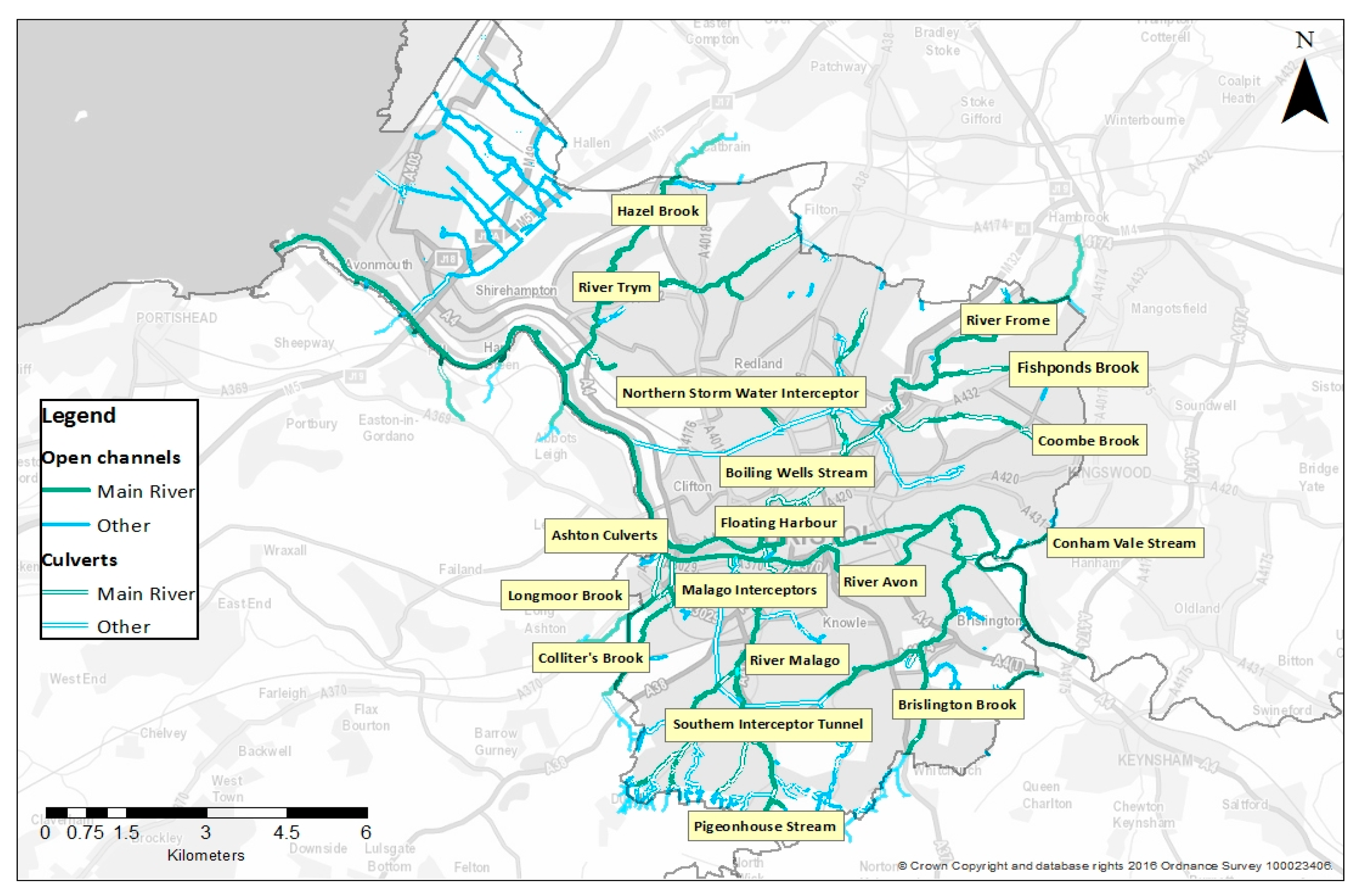

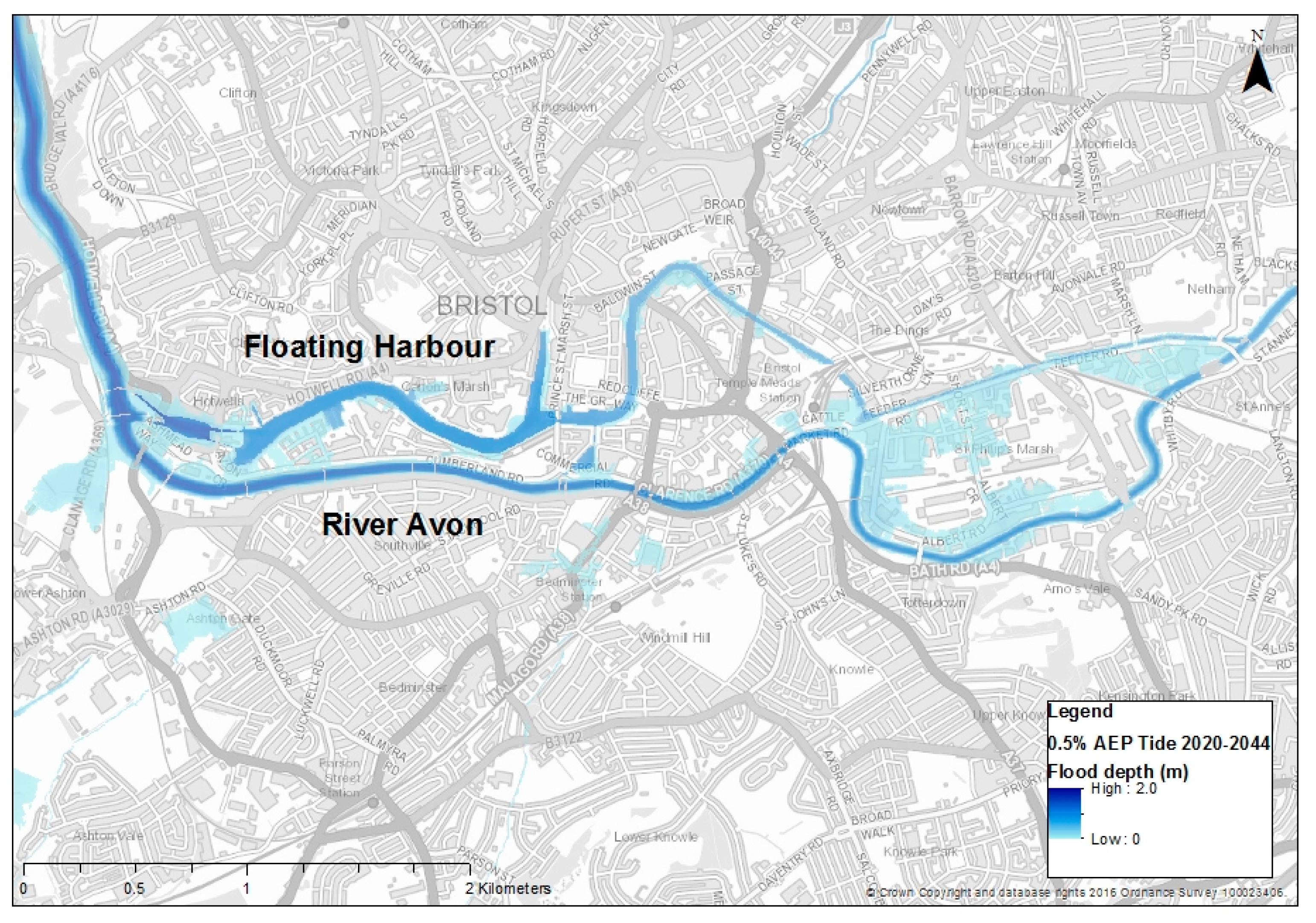
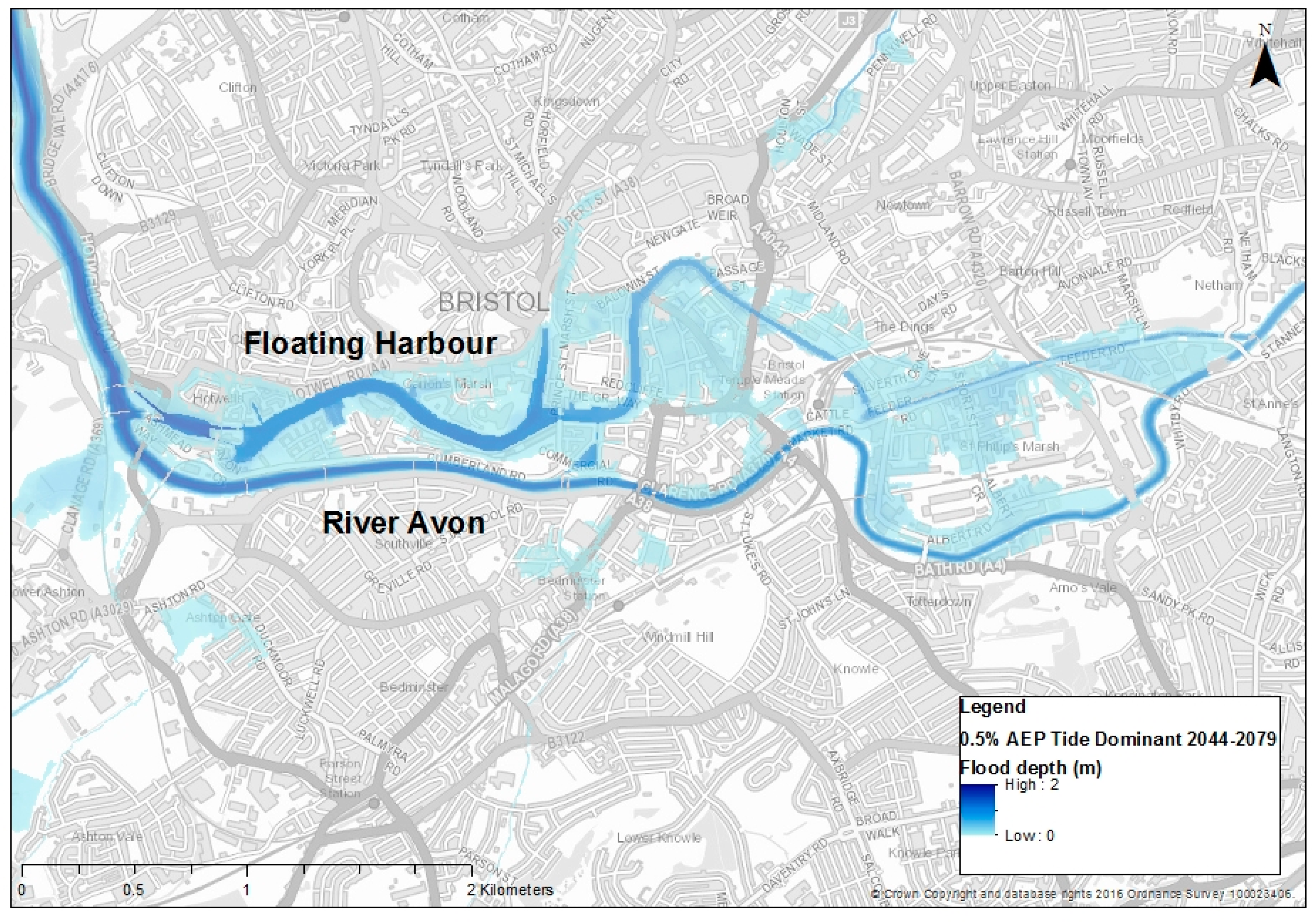
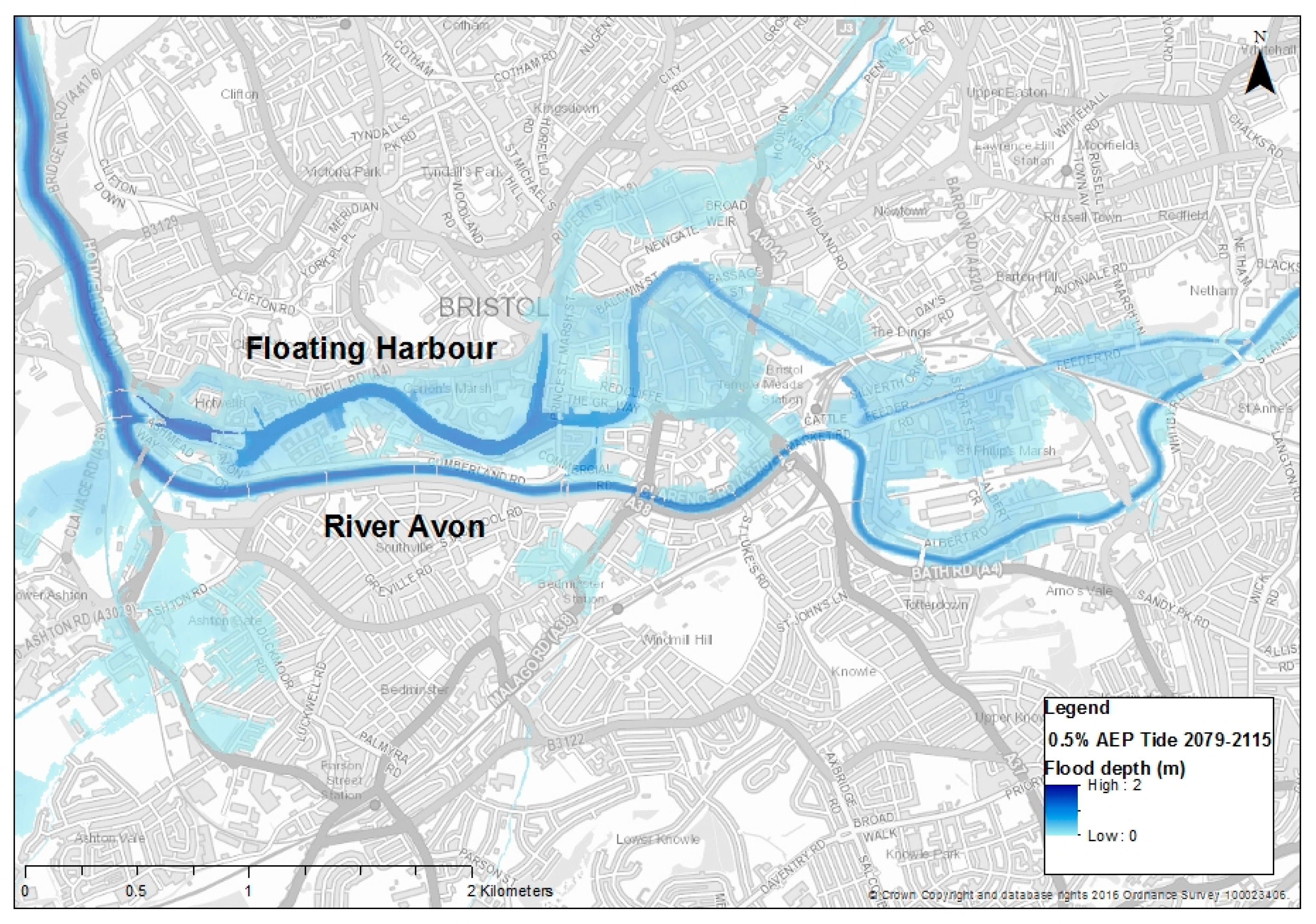

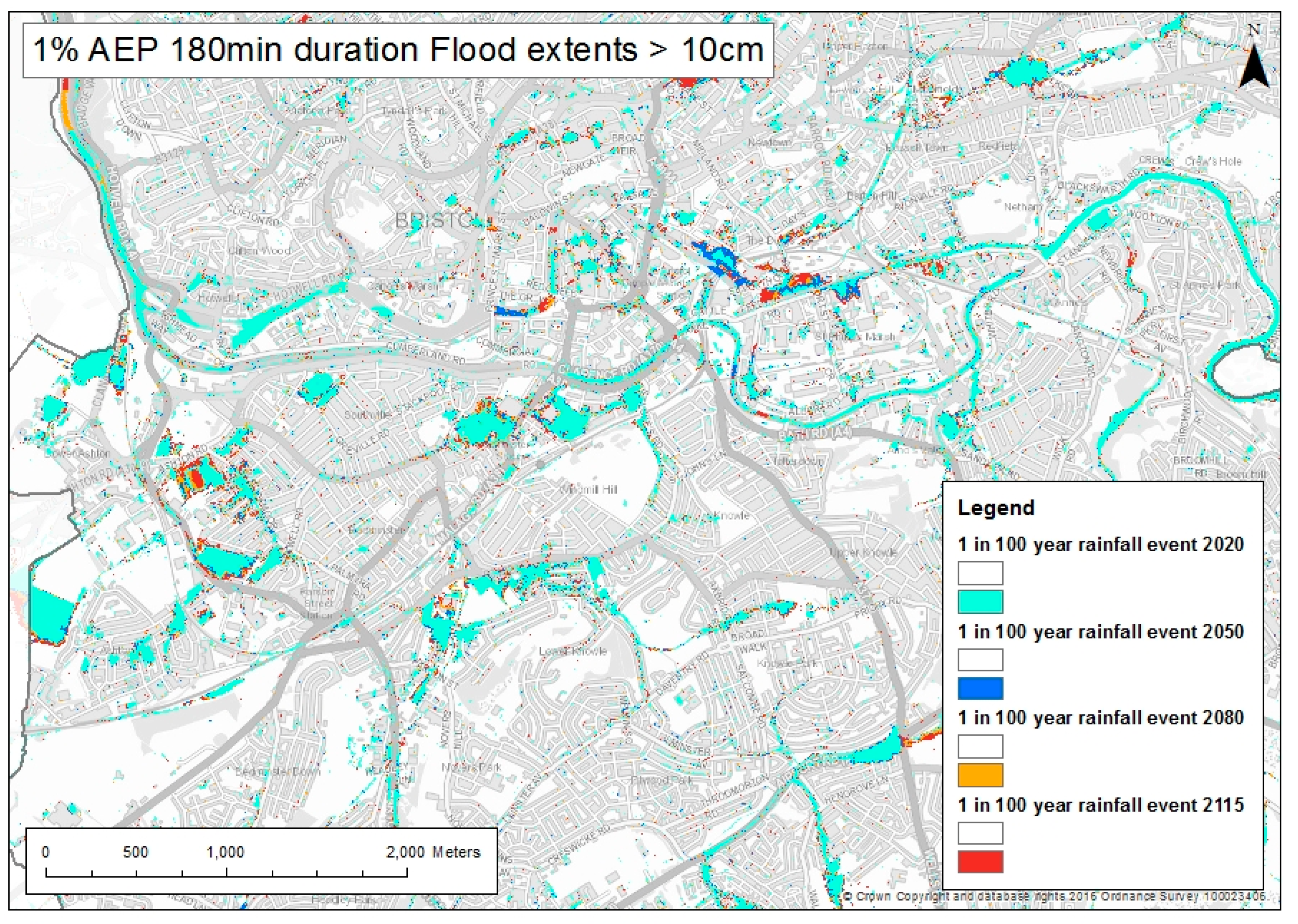

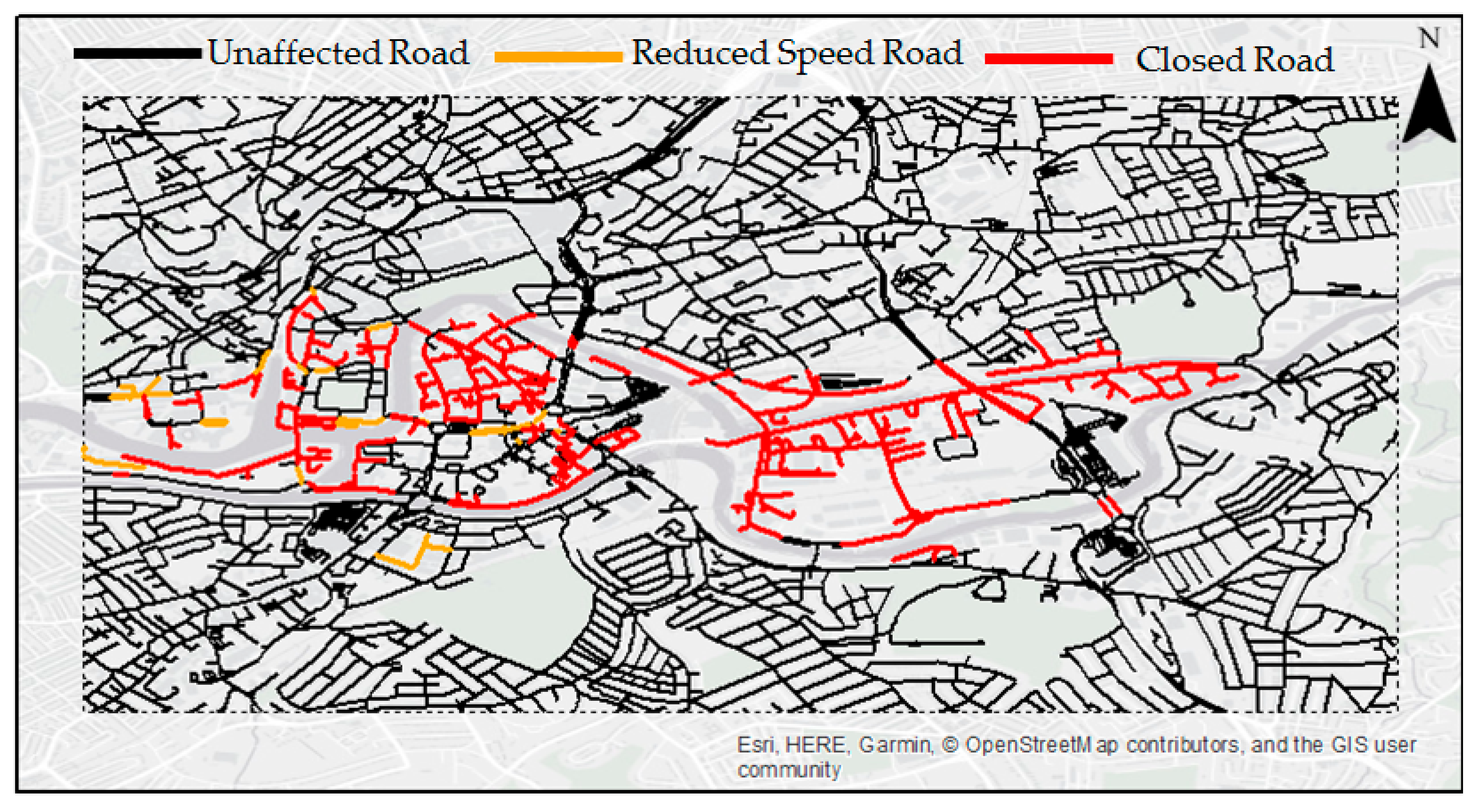

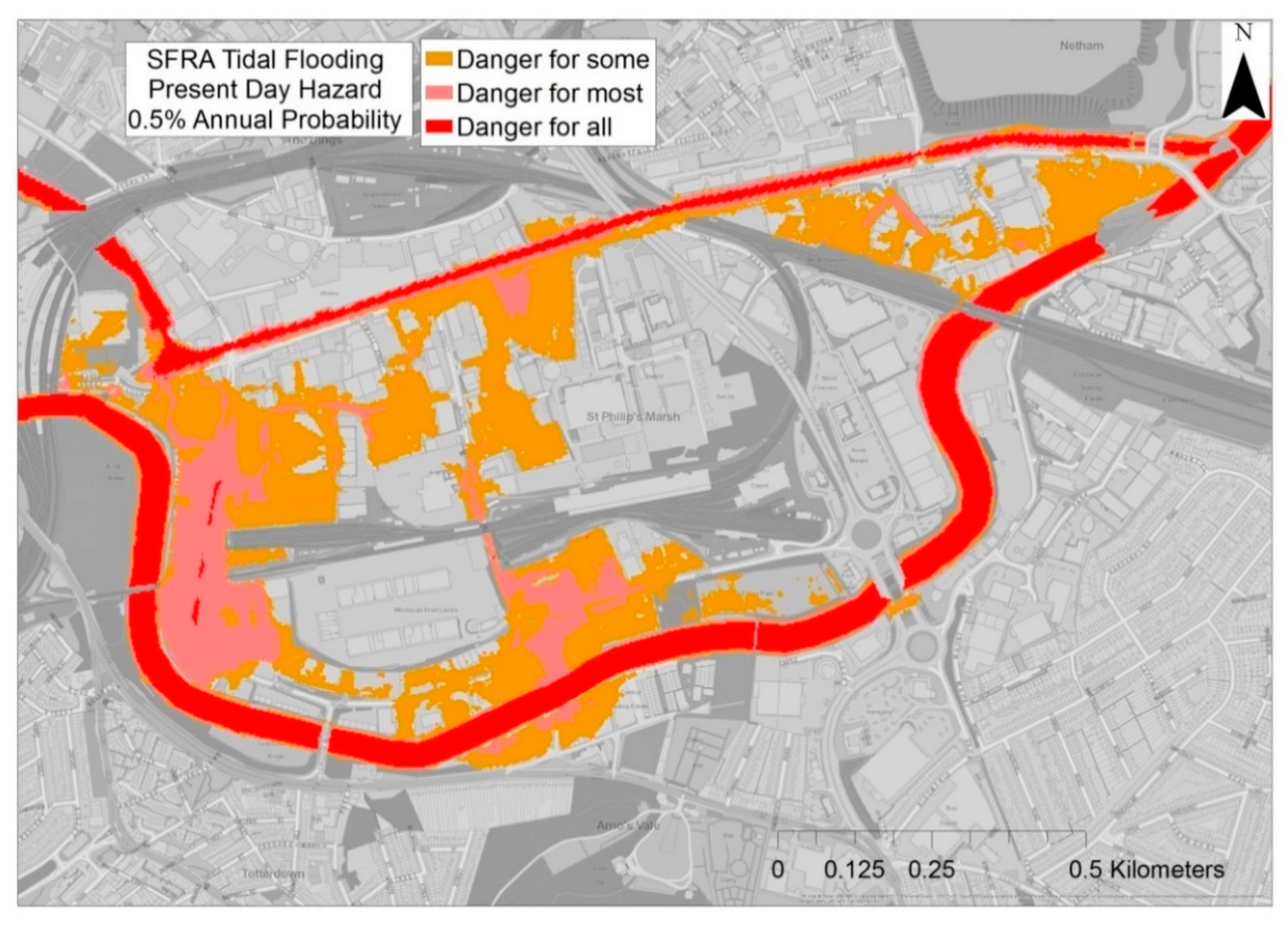
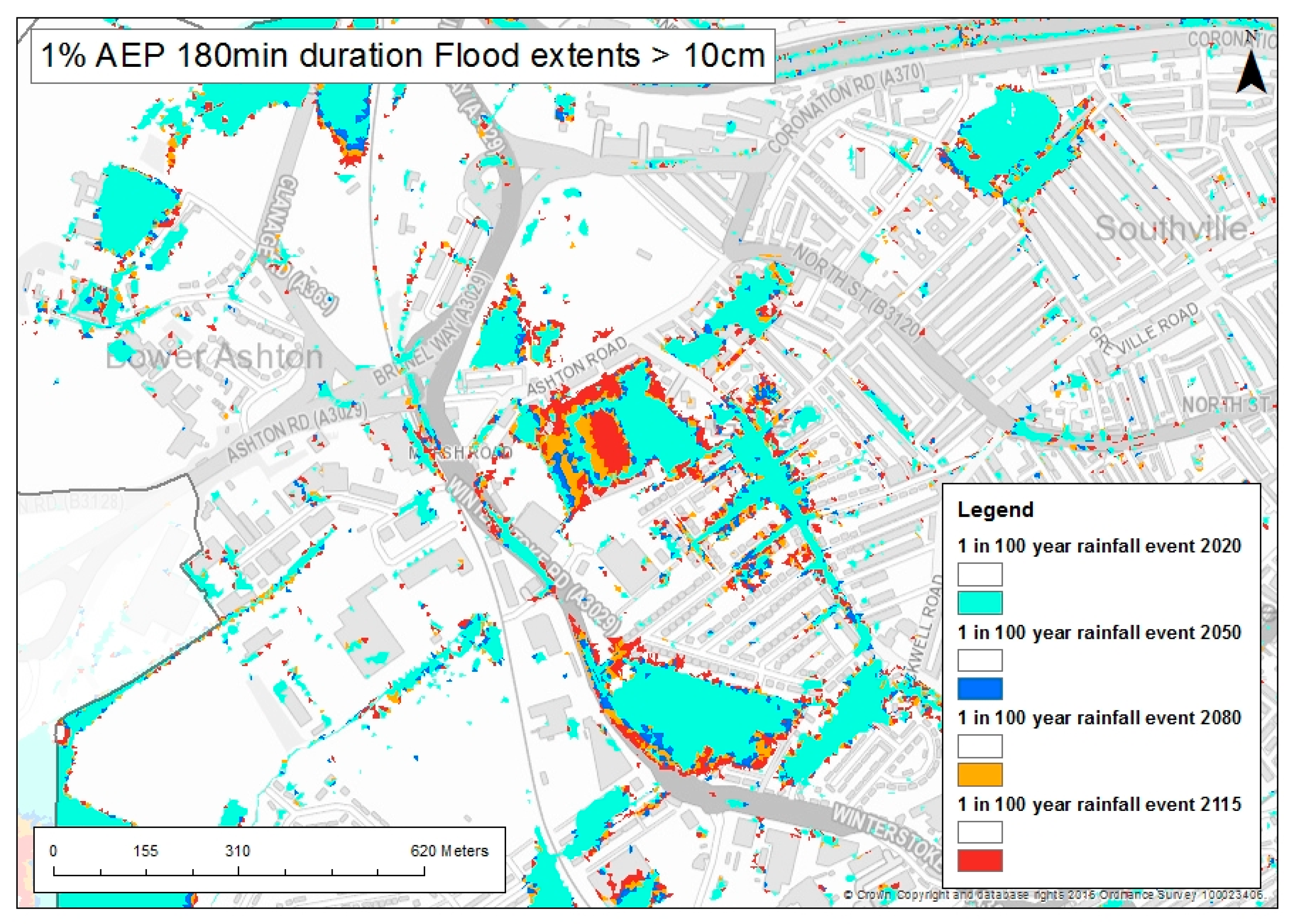
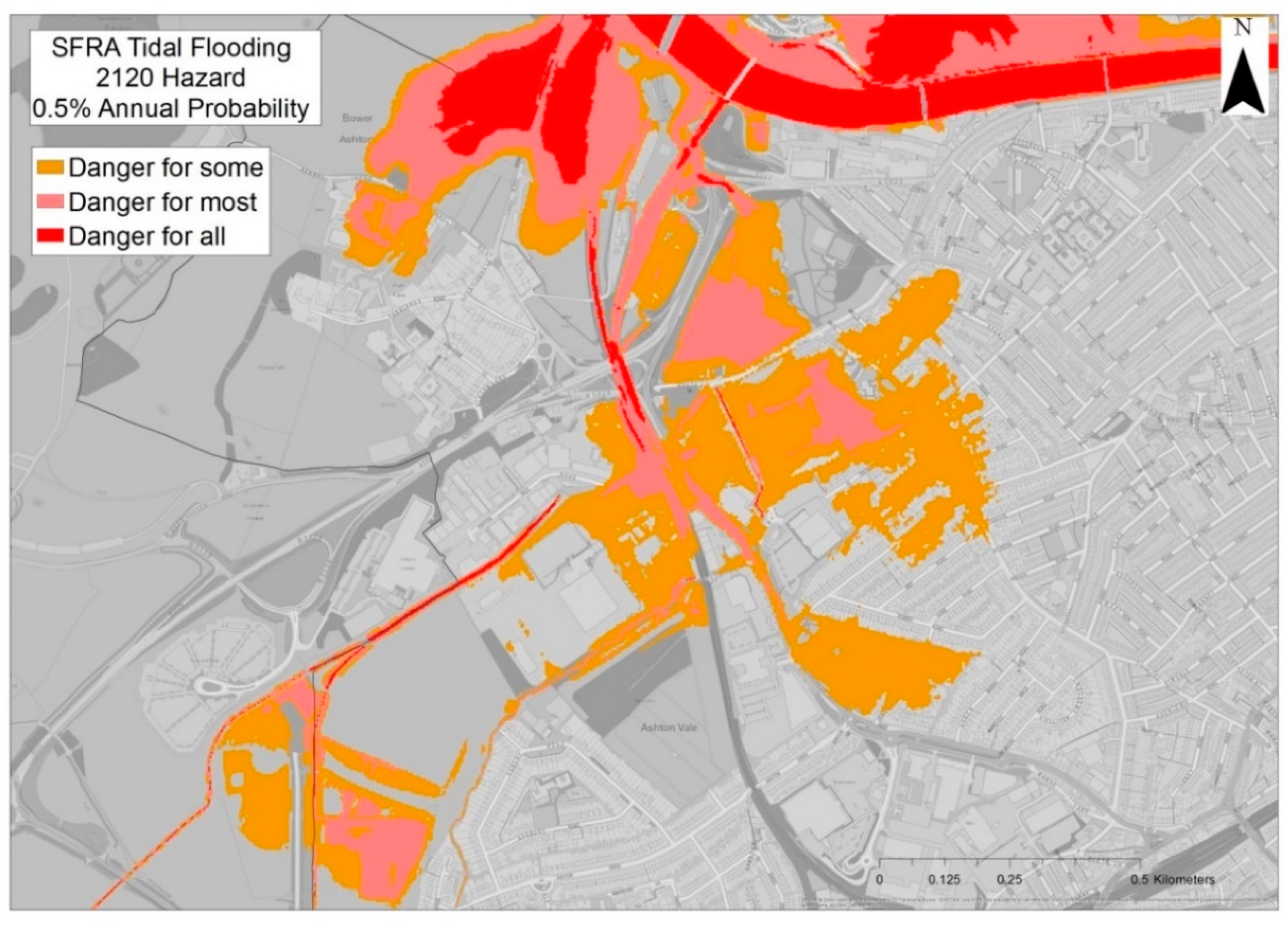
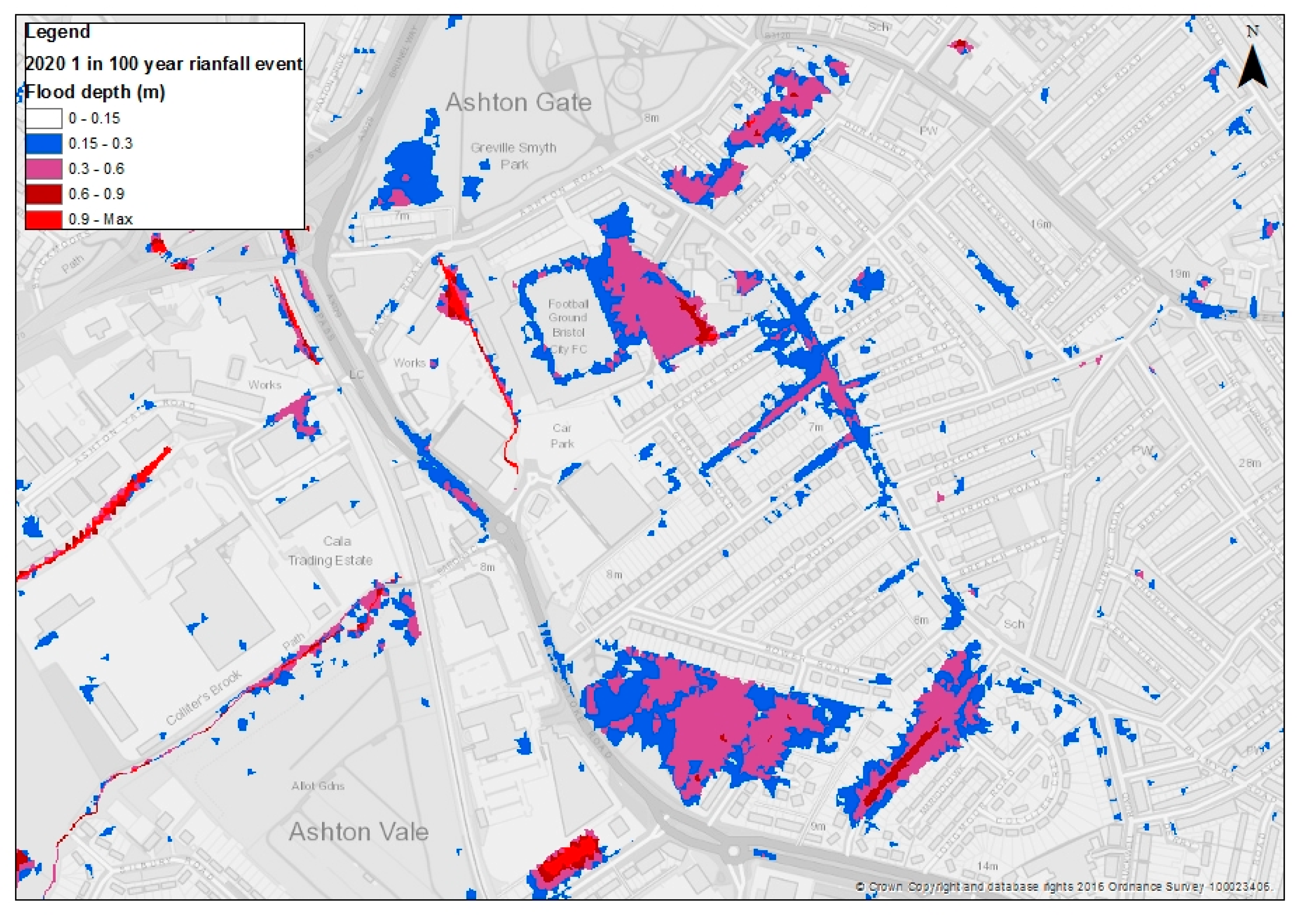
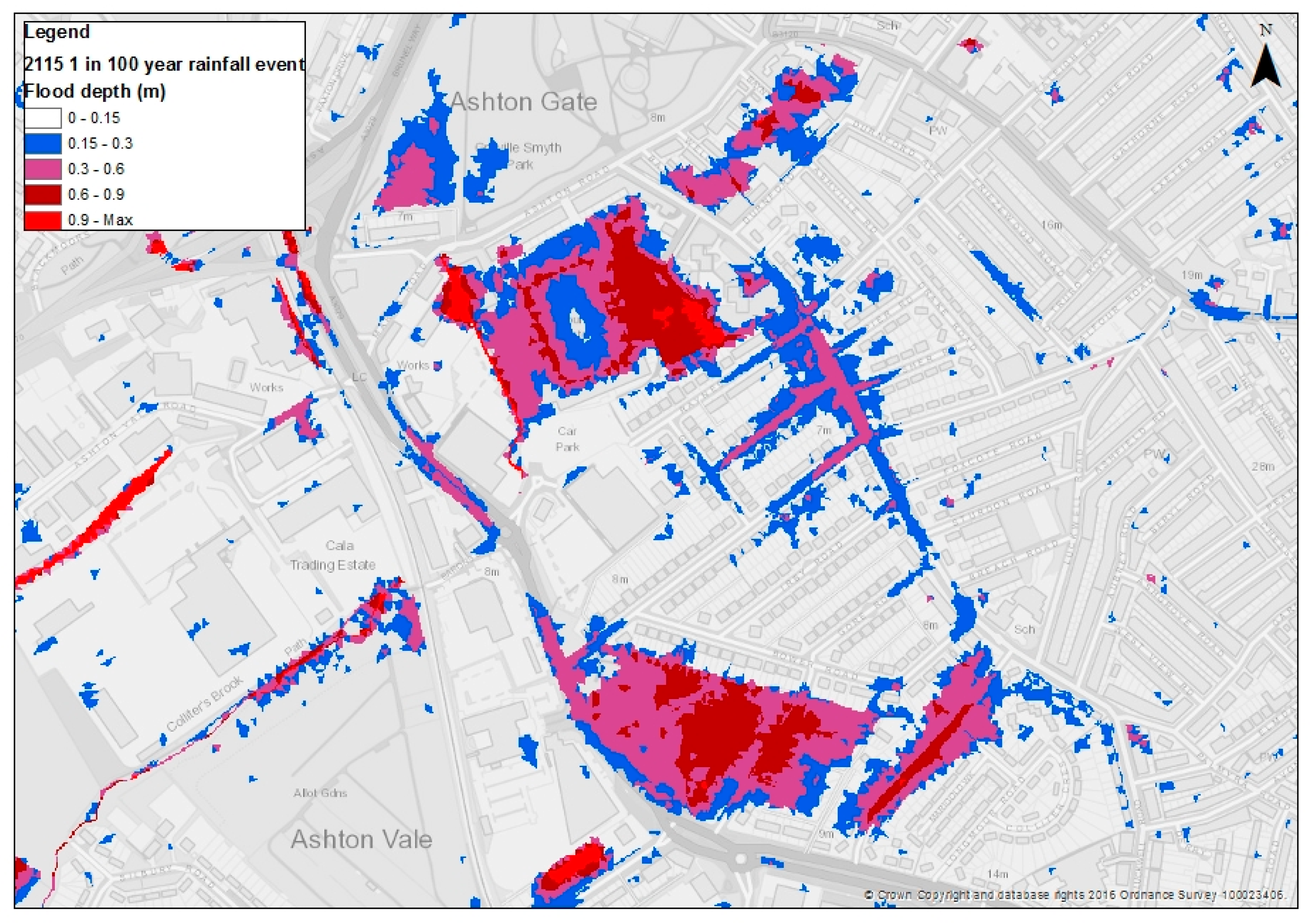
| Epoch | 1990 to 2025 | 2026 to 2055 | 2056 to 2085 | 2086 to 2115 | Cumulative Rise 1990 to 2115 (m) |
|---|---|---|---|---|---|
| Rate of rise (mm/yr) | 3.5 | 8 | 11.5 | 14.5 | 1.11 |
| Cumulative rise in epoch (compared to 1990) (mm) | 123 | 232 | 334 | 421 |
| Velocity (m/s) | Depth of Flooding (m) | |||||||||||
|---|---|---|---|---|---|---|---|---|---|---|---|---|
| 0.05 | 0.1 | 0.2 | 0.3 | 0.4 | 0.5 | 0.6 | 0.8 | 1.0 | 1.5 | 2.0 | 2.5 | |
| 0.00 | ||||||||||||
| 0.1 | ||||||||||||
| 0.25 | ||||||||||||
| 0.5 | ||||||||||||
| 1.0 | ||||||||||||
| 1.5 | ||||||||||||
| 2.0 | ||||||||||||
| 2.5 | ||||||||||||
| 3.0 | ||||||||||||
| 3.5 | ||||||||||||
| 4.0 | ||||||||||||
| 4.5 | ||||||||||||
| 5.0 | ||||||||||||
| Key: | ||||||||||||
| Danger for some | ||||||||||||
| Danger for most | ||||||||||||
| Danger for all | ||||||||||||
| Water Depth | Type of Substation | Number of Occurrences | Percentage over Total | ||||
|---|---|---|---|---|---|---|---|
| T20 | T200 | T1000 | T20 | T20 | T200 | ||
| 0.1 m < AWD ≤ 0.8 m | 11 kV | 80 | 49 | 41 | 18.6% | 11.4% | 9.5% |
| 33 kV | 0 | 1 | 1 | 0.0% | 33.3% | 33.3% | |
| 132 kV | 0 | 0 | 0 | 0.0% | 0.0% | 0.0% | |
| 0.8 m < AWD ≤ 1.6 m | 11 kV | 19 | 92 | 87 | 4.4% | 21.4% | 20.2% |
| 132 kV | 0 | 1 | 1 | 0.0% | 100.0% | 100.0% | |
| AWD > 1.6 m | 11kV | 2 | 56 | 76 | 0.5% | 13.0% | 17.7% |
| Decade | Critical Tide Level (7.5mAOD) Is Exceeded (%, Percentage of Time in a Year, on Average) | Extreme Tide Level (8.0mAOD) Is Exceeded (%, Percentage of Time in a Year, on Average) |
|---|---|---|
| 2010 | 0.34 | 0.04 |
| 2050 | 0.63 | 0.13 |
| 2080 | 1.30 | 0.39 |
| 2110 | 2.04 | 0.79 |
© 2020 by the authors. Licensee MDPI, Basel, Switzerland. This article is an open access article distributed under the terms and conditions of the Creative Commons Attribution (CC BY) license (http://creativecommons.org/licenses/by/4.0/).
Share and Cite
Stevens, J.; Henderson, R.; Webber, J.; Evans, B.; Chen, A.; Djordjević, S.; Sánchez-Muñoz, D.; Domínguez-García, J. Interlinking Bristol Based Models to Build Resilience to Climate Change. Sustainability 2020, 12, 3233. https://doi.org/10.3390/su12083233
Stevens J, Henderson R, Webber J, Evans B, Chen A, Djordjević S, Sánchez-Muñoz D, Domínguez-García J. Interlinking Bristol Based Models to Build Resilience to Climate Change. Sustainability. 2020; 12(8):3233. https://doi.org/10.3390/su12083233
Chicago/Turabian StyleStevens, John, Rob Henderson, James Webber, Barry Evans, Albert Chen, Slobodan Djordjević, Daniel Sánchez-Muñoz, and José Domínguez-García. 2020. "Interlinking Bristol Based Models to Build Resilience to Climate Change" Sustainability 12, no. 8: 3233. https://doi.org/10.3390/su12083233
APA StyleStevens, J., Henderson, R., Webber, J., Evans, B., Chen, A., Djordjević, S., Sánchez-Muñoz, D., & Domínguez-García, J. (2020). Interlinking Bristol Based Models to Build Resilience to Climate Change. Sustainability, 12(8), 3233. https://doi.org/10.3390/su12083233








